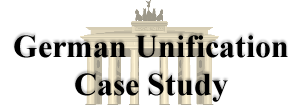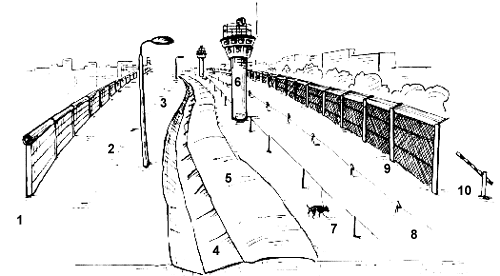
The Berlin Wall
Home
Introduction
Historical Background
The
Discussion
Goals &
Issues
Characters
Teacher's
Guide
Index
Travelling to Berlin, the visitor will have great difficulty in locating remnants and even the former location of what was called ‘the Wall’. Yet, between 1961 and 1989, the Wall was one of the most striking and distinctive features of Berlin. The Berlin Wall was a border security installation built by the German Democratic Republic (GDR) on August 12, 1961. Officially called the Antifaschistischer Schutzwall (anti-fascist protection dike), the wall was to protect the GDR from aggressive acts by the West. In reality, the Wall functioned as a barrier to stem the massive exodus of skilled laborers to West-Berlin and from there to West-Germany. In addition to the Wall in Berlin, the GDR installed an elaborate security system along the inner German-German border (see illustration). Until 1983 and 1985 respectively, this included a Selbstschußanlage (a shooting installation which was triggered by a fugitive) and a land mine field.
The Berlin Wall was a structure which divided the city, and encased the French, British and American sectors of Berlin. Thus, these three sectors, which comprised West Berlin, became an island surrounded by East German (GDR) territory. The Wall dissected eight train lines, four underground train lines and 193 major and minor roads. In total, the wall measured 97 miles. This included 27 miles through the city center (of which 23 miles cut through residential areas), 19 miles through woodlands and forests and 15 miles through rivers and lakes.
Initially, the wall consisted of a brick structure, 2.5 feet wide and over 7 feet high. But by 1989, the Wall had developed into a multilayered security installation (see illustration below) that included a concrete wall, trenches, 300 watch towers, an area controlled by dogs, a signal constructions with trip wires, 22 bunkers and a border signal fence. Obviously, the construction and maintenance of the Wall was accompanied by tremendous costs. General Teichmann, the last Chief of the border troops, reported in February of 1990 that construction costs of the border security installation alone had exceeded 850 million GDR marks.
- Concrete segment wall (front barrier element)
- Control Area
- Light masts
- Trench to block the way for vehicles
- Concrete road
- Watch tower
- Area patrolled by dogs
- Signal construction with trip wires
- Border signal fence
- Turnpike (bounds of protection area)
The Wall was considered a Gernzgebiet (border) by the East German government. As such, the Wall as well as the area immediately adjoining the fortification on the East German side, called the Sicherungsstreifen (security area), were subject to particular legal provisions. The Grenztruppen (border troops) patrolled the multi-layered security installation (the Wall), whereas the security area was patrolled by the Volkspolizei (People's Police) and the Staatssicherheit (State Security). Since Berlin was a densely populated city, many people lived in the area that was designated the security area. However, anyone entering the security area had to show an identification card or special permit. As time progressed, more and more East German buildings immediately adjacent to the Wall were vacated by the government, and the windows overlooking the Wall to the West were boarded up.
It was the duty of the border troops to prevent East Germans from crossing the border to the West. The border troops, like all armed forces in the GDR, were under the order of the Schußwaffenanwendungsordnung (use of fire-arms regulation) which spelled out when and under which circumstances to use fire power. Before using a gun, a border guard had to call and order the fugitive to stop. If this step failed, the border guard was to fire a warning shot in the air. If the fugitive subsequently did not stop, the border guard was to use all means to prevent the border crossing. According to Western figures on the Berlin Wall, 118 people were injured by border shootings and 80 people were killed (720 additional fatalities ocurred at the German-German border from 1949-1989). 3,221 East Germans failed to cross the Berlin Wall and were arrested, and 5,043 Mauerbrecher (wall crossers) were successful in reaching West-Berlin.
<< Previous
Goals & Issues - Characters - Teacher's Guide - Index

Foothill College, 12345 El Monte Road, Los Altos Hills, CA 94022-4599
News & Info - Apply & Register - Degrees & Programs - Catalog & Schedule - Student Services
